Abstract
Both human and mouse c-kit ligand induced differentiation of human mast cells in a long-term culture of the mononuclear cells of umbilical cord blood. Growth factor activity for human mast cells present in conditioned medium of BALB/3T3 fibroblasts was due to mouse c-kit ligand. Recombinant c-kit ligand induced differentiation and proliferation of mast cell progenitors in early stages of culture. However, apparent selective growth of mast cells by c-kit ligand in cord blood cell cultures is mainly due to the effect of the cytokine to selectively maintain survival of immature mast cells. Electron microscopic analysis indicated that human mast cells developed by c-kit ligand were similar to human mast cells in the lung and gut mucosa, while those developed in coculture of cord blood cells with Swiss albino/3T3 fibroblasts were similar to skin mast cells. This conclusion was supported by the fact that the majority of mast cells developed by c-kit ligand contained only tryptase in their granules, whereas those developed in the cocultures contained both tryptase and chymase. It was also found that mast cells developed by c-kit ligand were immature even after culture for 14 weeks. Nevertheless, these cells express Fc epsilon RI, and could be sensitized with human IgE for anti-IgE-induced release of histamine, prostaglandin D2, and leukotriene C4.
Full text
PDF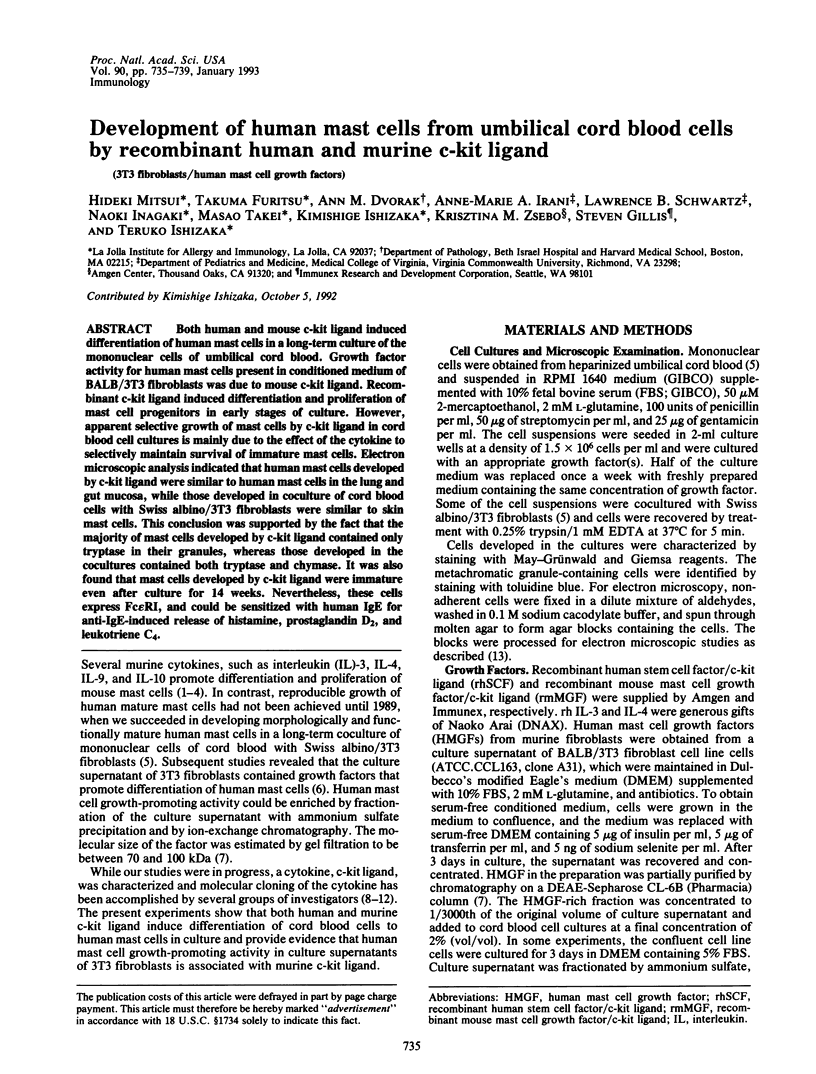
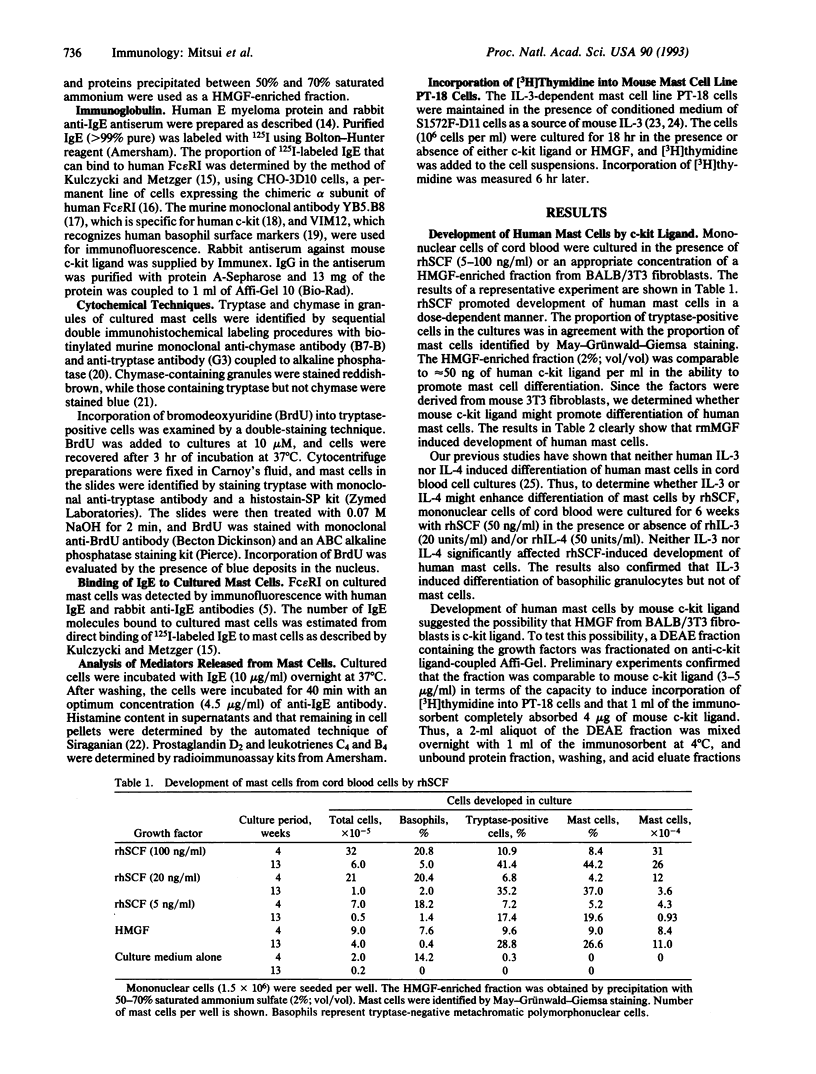
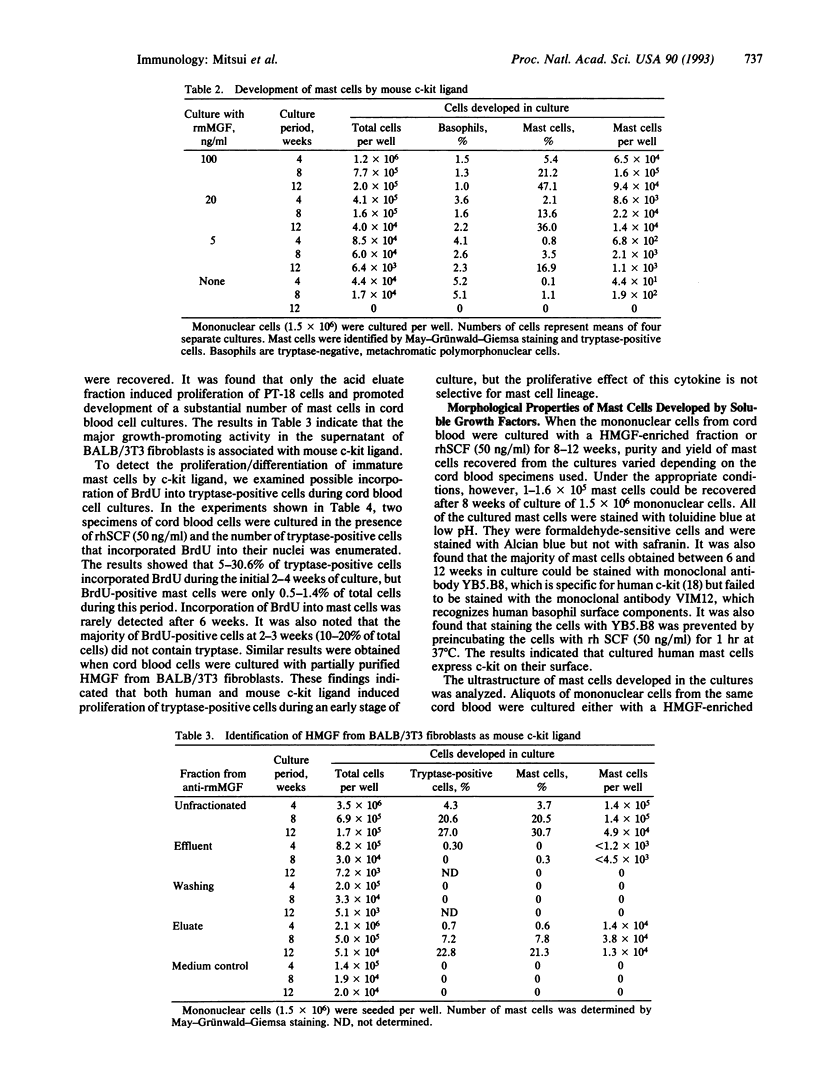
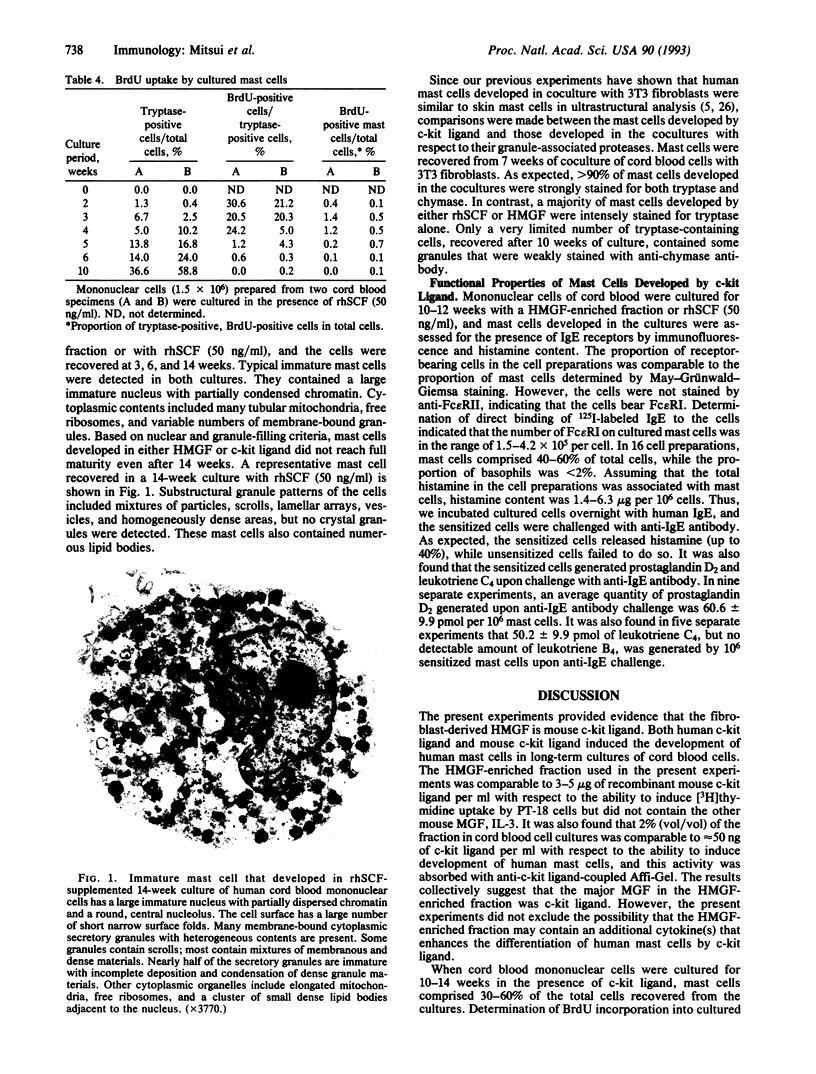
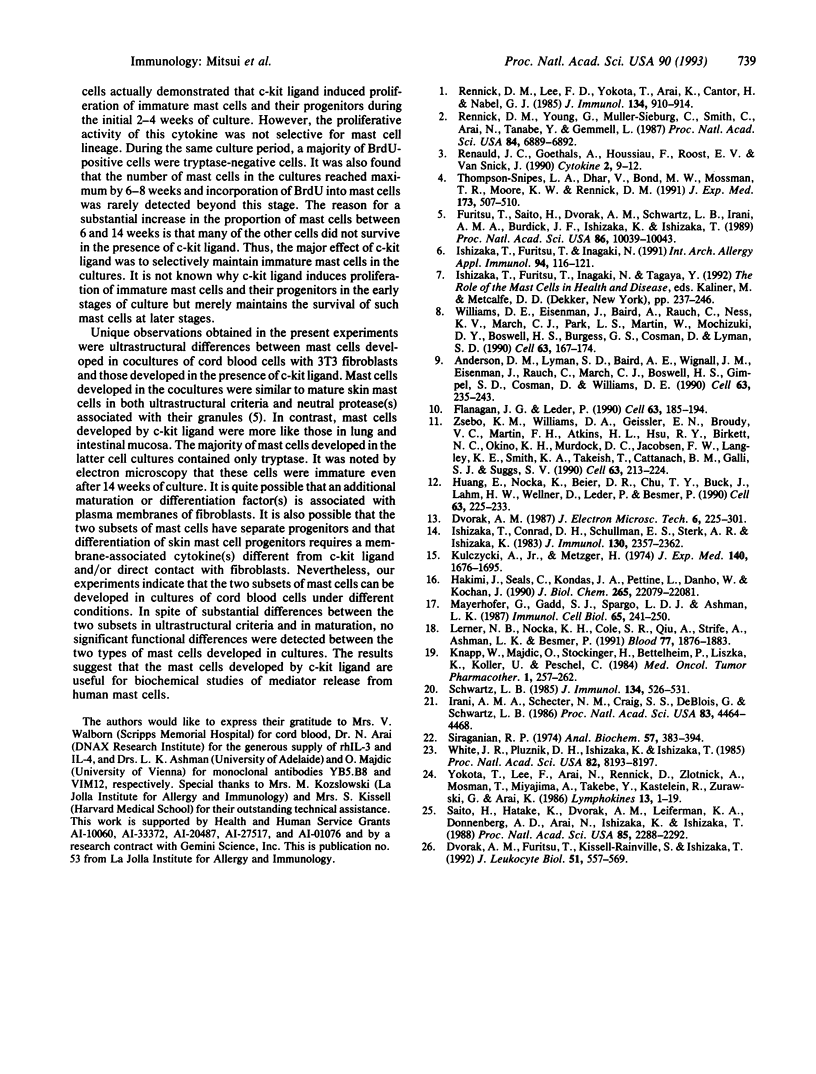
Images in this article
Selected References
These references are in PubMed. This may not be the complete list of references from this article.
- Anderson D. M., Lyman S. D., Baird A., Wignall J. M., Eisenman J., Rauch C., March C. J., Boswell H. S., Gimpel S. D., Cosman D. Molecular cloning of mast cell growth factor, a hematopoietin that is active in both membrane bound and soluble forms. Cell. 1990 Oct 5;63(1):235–243. doi: 10.1016/0092-8674(90)90304-w. [DOI] [PubMed] [Google Scholar]
- Dvorak A. M., Furitsu T., Kissell-Rainville S., Ishizaka T. Ultrastructural identification of human mast cells resembling skin mast cells stimulated to develop in long-term human cord blood mononuclear cells cultured with 3T3 murine skin fibroblasts. J Leukoc Biol. 1992 Jun;51(6):557–569. doi: 10.1002/jlb.51.6.557. [DOI] [PubMed] [Google Scholar]
- Flanagan J. G., Leder P. The kit ligand: a cell surface molecule altered in steel mutant fibroblasts. Cell. 1990 Oct 5;63(1):185–194. doi: 10.1016/0092-8674(90)90299-t. [DOI] [PubMed] [Google Scholar]
- Furitsu T., Saito H., Dvorak A. M., Schwartz L. B., Irani A. M., Burdick J. F., Ishizaka K., Ishizaka T. Development of human mast cells in vitro. Proc Natl Acad Sci U S A. 1989 Dec;86(24):10039–10043. doi: 10.1073/pnas.86.24.10039. [DOI] [PMC free article] [PubMed] [Google Scholar]
- Hakimi J., Seals C., Kondas J. A., Pettine L., Danho W., Kochan J. The alpha subunit of the human IgE receptor (FcERI) is sufficient for high affinity IgE binding. J Biol Chem. 1990 Dec 25;265(36):22079–22081. [PubMed] [Google Scholar]
- Huang E., Nocka K., Beier D. R., Chu T. Y., Buck J., Lahm H. W., Wellner D., Leder P., Besmer P. The hematopoietic growth factor KL is encoded by the Sl locus and is the ligand of the c-kit receptor, the gene product of the W locus. Cell. 1990 Oct 5;63(1):225–233. doi: 10.1016/0092-8674(90)90303-v. [DOI] [PubMed] [Google Scholar]
- Irani A. A., Schechter N. M., Craig S. S., DeBlois G., Schwartz L. B. Two types of human mast cells that have distinct neutral protease compositions. Proc Natl Acad Sci U S A. 1986 Jun;83(12):4464–4468. doi: 10.1073/pnas.83.12.4464. [DOI] [PMC free article] [PubMed] [Google Scholar]
- Ishizaka T., Conrad D. H., Schulman E. S., Sterk A. R., Ishizaka K. Biochemical analysis of initial triggering events of IgE-mediated histamine release from human lung mast cells. J Immunol. 1983 May;130(5):2357–2362. [PubMed] [Google Scholar]
- Ishizaka T., Furitsu T., Inagaki N. In vitro development and functions of human mast cells. Int Arch Allergy Appl Immunol. 1991;94(1-4):116–121. doi: 10.1159/000235341. [DOI] [PubMed] [Google Scholar]
- Knapp W., Majdic O., Stockinger H., Bettelheim P., Liszka K., Köller U., Peschel C. Monoclonal antibodies to human myelomonocyte differentiation antigens in the diagnosis of acute myeloid leukemia. Med Oncol Tumor Pharmacother. 1984;1(4):257–262. doi: 10.1007/BF02934532. [DOI] [PubMed] [Google Scholar]
- Kulczycki A., Jr, Metzger H. The interaction of IgE with rat basophilic leukemia cells. II. Quantitative aspects of the binding reaction. J Exp Med. 1974 Dec 1;140(6):1676–1695. doi: 10.1084/jem.140.6.1676. [DOI] [PMC free article] [PubMed] [Google Scholar]
- Lerner N. B., Nocka K. H., Cole S. R., Qiu F. H., Strife A., Ashman L. K., Besmer P. Monoclonal antibody YB5.B8 identifies the human c-kit protein product. Blood. 1991 May 1;77(9):1876–1883. [PubMed] [Google Scholar]
- Mayrhofer G., Gadd S. J., Spargo L. D., Ashman L. K. Specificity of a mouse monoclonal antibody raised against acute myeloid leukaemia cells for mast cells in human mucosal and connective tissues. Immunol Cell Biol. 1987 Jun;65(Pt 3):241–250. doi: 10.1038/icb.1987.27. [DOI] [PubMed] [Google Scholar]
- Renauld J. C., Goethals A., Houssiau F., Van Roost E., Van Snick J. Cloning and expression of a cDNA for the human homolog of mouse T cell and mast cell growth factor P40. Cytokine. 1990 Jan;2(1):9–12. doi: 10.1016/1043-4666(90)90037-t. [DOI] [PubMed] [Google Scholar]
- Rennick D. M., Lee F. D., Yokota T., Arai K. I., Cantor H., Nabel G. J. A cloned MCGF cDNA encodes a multilineage hematopoietic growth factor: multiple activities of interleukin 3. J Immunol. 1985 Feb;134(2):910–914. [PubMed] [Google Scholar]
- Rennick D., Yang G., Muller-Sieburg C., Smith C., Arai N., Takabe Y., Gemmell L. Interleukin 4 (B-cell stimulatory factor 1) can enhance or antagonize the factor-dependent growth of hemopoietic progenitor cells. Proc Natl Acad Sci U S A. 1987 Oct;84(19):6889–6893. doi: 10.1073/pnas.84.19.6889. [DOI] [PMC free article] [PubMed] [Google Scholar]
- Saito H., Hatake K., Dvorak A. M., Leiferman K. M., Donnenberg A. D., Arai N., Ishizaka K., Ishizaka T. Selective differentiation and proliferation of hematopoietic cells induced by recombinant human interleukins. Proc Natl Acad Sci U S A. 1988 Apr;85(7):2288–2292. doi: 10.1073/pnas.85.7.2288. [DOI] [PMC free article] [PubMed] [Google Scholar]
- Schwartz L. B. Monoclonal antibodies against human mast cell tryptase demonstrate shared antigenic sites on subunits of tryptase and selective localization of the enzyme to mast cells. J Immunol. 1985 Jan;134(1):526–531. [PubMed] [Google Scholar]
- Siraganian R. P. An automated continuous-flow system for the extraction and fluorometric analysis of histamine. Anal Biochem. 1974 Feb;57(2):383–394. doi: 10.1016/0003-2697(74)90093-1. [DOI] [PubMed] [Google Scholar]
- Thompson-Snipes L., Dhar V., Bond M. W., Mosmann T. R., Moore K. W., Rennick D. M. Interleukin 10: a novel stimulatory factor for mast cells and their progenitors. J Exp Med. 1991 Feb 1;173(2):507–510. doi: 10.1084/jem.173.2.507. [DOI] [PMC free article] [PubMed] [Google Scholar]
- White J. R., Pluznik D. H., Ishizaka K., Ishizaka T. Antigen-induced increase in protein kinase C activity in plasma membrane of mast cells. Proc Natl Acad Sci U S A. 1985 Dec;82(23):8193–8197. doi: 10.1073/pnas.82.23.8193. [DOI] [PMC free article] [PubMed] [Google Scholar]
- Williams D. E., Eisenman J., Baird A., Rauch C., Van Ness K., March C. J., Park L. S., Martin U., Mochizuki D. Y., Boswell H. S. Identification of a ligand for the c-kit proto-oncogene. Cell. 1990 Oct 5;63(1):167–174. doi: 10.1016/0092-8674(90)90297-r. [DOI] [PubMed] [Google Scholar]
- Zsebo K. M., Williams D. A., Geissler E. N., Broudy V. C., Martin F. H., Atkins H. L., Hsu R. Y., Birkett N. C., Okino K. H., Murdock D. C. Stem cell factor is encoded at the Sl locus of the mouse and is the ligand for the c-kit tyrosine kinase receptor. Cell. 1990 Oct 5;63(1):213–224. doi: 10.1016/0092-8674(90)90302-u. [DOI] [PubMed] [Google Scholar]



